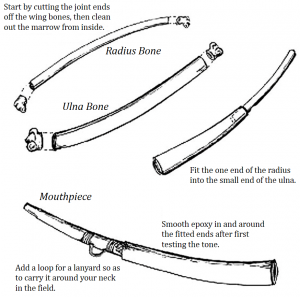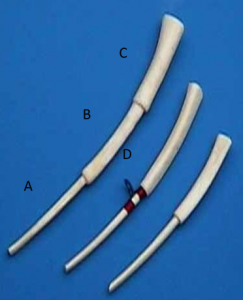 Traditional crafting is a wonderful 4-H youth activity. The parts to construct replica tools or items are generally inexpensive since they are mostly made from natural or primitive-like materials. In addition, crafting helps youth to learn about skills and/or traditions of our ancestors and allows for hands-on expression of their creativity, as well as a sense of accomplishment in making something they can use or gift to others.
Traditional crafting is a wonderful 4-H youth activity. The parts to construct replica tools or items are generally inexpensive since they are mostly made from natural or primitive-like materials. In addition, crafting helps youth to learn about skills and/or traditions of our ancestors and allows for hands-on expression of their creativity, as well as a sense of accomplishment in making something they can use or gift to others.
Basic History of Call Making
 When the first turkey call was made is not known. We do however have a good idea when the first calls were already in use. In 1940 the Eva archaic site located in Benton County, Tennessee was excavated prior to the construction of the dam that formed Kentucky Lake. Many early Indian artifacts were unearthed at this time. One of the more interesting items found, at least from this point of view, were wingbone style yelpers made from bone and antler materials. Close examination showed that these calls were made from the actual wing bones of turkeys. Microscopic analysis showed that the bones were heavily worked by being scraped, cut and fit together much like the calls we are used to seeing today. They were accurately dated to 6500 BC.
When the first turkey call was made is not known. We do however have a good idea when the first calls were already in use. In 1940 the Eva archaic site located in Benton County, Tennessee was excavated prior to the construction of the dam that formed Kentucky Lake. Many early Indian artifacts were unearthed at this time. One of the more interesting items found, at least from this point of view, were wingbone style yelpers made from bone and antler materials. Close examination showed that these calls were made from the actual wing bones of turkeys. Microscopic analysis showed that the bones were heavily worked by being scraped, cut and fit together much like the calls we are used to seeing today. They were accurately dated to 6500 BC.

Parts of a Turkey Call
A typical wingbone call is made of three sections of bone:
– radius for a mouthpiece
– ulna for the mid-section
– humerus for the sound bell

Instructions On How to Make a Wingbone Turkey Call
A wingbone yelper is one tool that holds great appeal for turkey hunters. It conveys a sense of spirituality and connection with one’s prey by using non-edible parts of harvested birds to call living ones to the gun or bow. If taken care of properly, one of these can last a lifetime. It can produce an array of turkey sounds with accuracy and clarity, it’s essentially weatherproof, and has considerable aesthetic appeal. Wingbone calls come in various styles and configurations, but in my opinion the most functional one—and the simplest to make—is a two-piece design utilizing the radius and ulna bones from a turkey’s wing. With a few decorative touches, your wingbone call will also serve as a source of pride.
Step 1
Begin by separating the radius and ulna from the wings. After removing as much meat and sinew from them as possible, use a rat-tail file, small hacksaw or Dremel® to cut away the joints at each end of the two bones, making the cuts as close to the joints as possible. Then use a pipe cleaner or thin piece of wire to remove marrow inside the bones. Next, boil the bones for an hour or until you can easily remove any remaining flesh or sinew by scraping it away with a pocketknife. Soak the prepared bones in 3% Hydrogen Peroxide to whiten, if desired. The level of whitening could take a few days or weeks, depending on what you like. Mason jars works well for this purpose.
 Step 2
Step 2
The standard construction of a wingbone yelper calls for the radius (A) to be inserted into the narrow end of the ulna (B) until it binds, and the ulna inserted into the humerus (C). The larger end of the humerus is the “bell” at the end of the call. When putting them together, keep the slight natural curve of the bones in alignment as you do so. The call can be a two or three section call. The three section call has a deeper tone. The bones are then epoxied together. You should get a nice fit and glued areas should be clean, dry, and grease free. Wrap the glued joints with heavy sewing thread of whatever color you like, and seal the wrappings with epoxy. An alternative is use natural color waxed string and tie a Whip Knot (below) over the joints. Wax string does not need to be epoxied. The Whip Knot can also be used to hold a lanyard or fishing pole rod guide (eyelet) (D).
By: Gus Koerner, 4-H Program Assistant, Andrea Lazzari, 4-H Agent, FS# 6174
Sources:
– National Wild Turkey Federation
– Call Makers & Collectors Association of America
– Outdoor Life Magazine, Turkey Calls: How Make Wingbone Yelper, Jim Casada March 2015
 0
0

